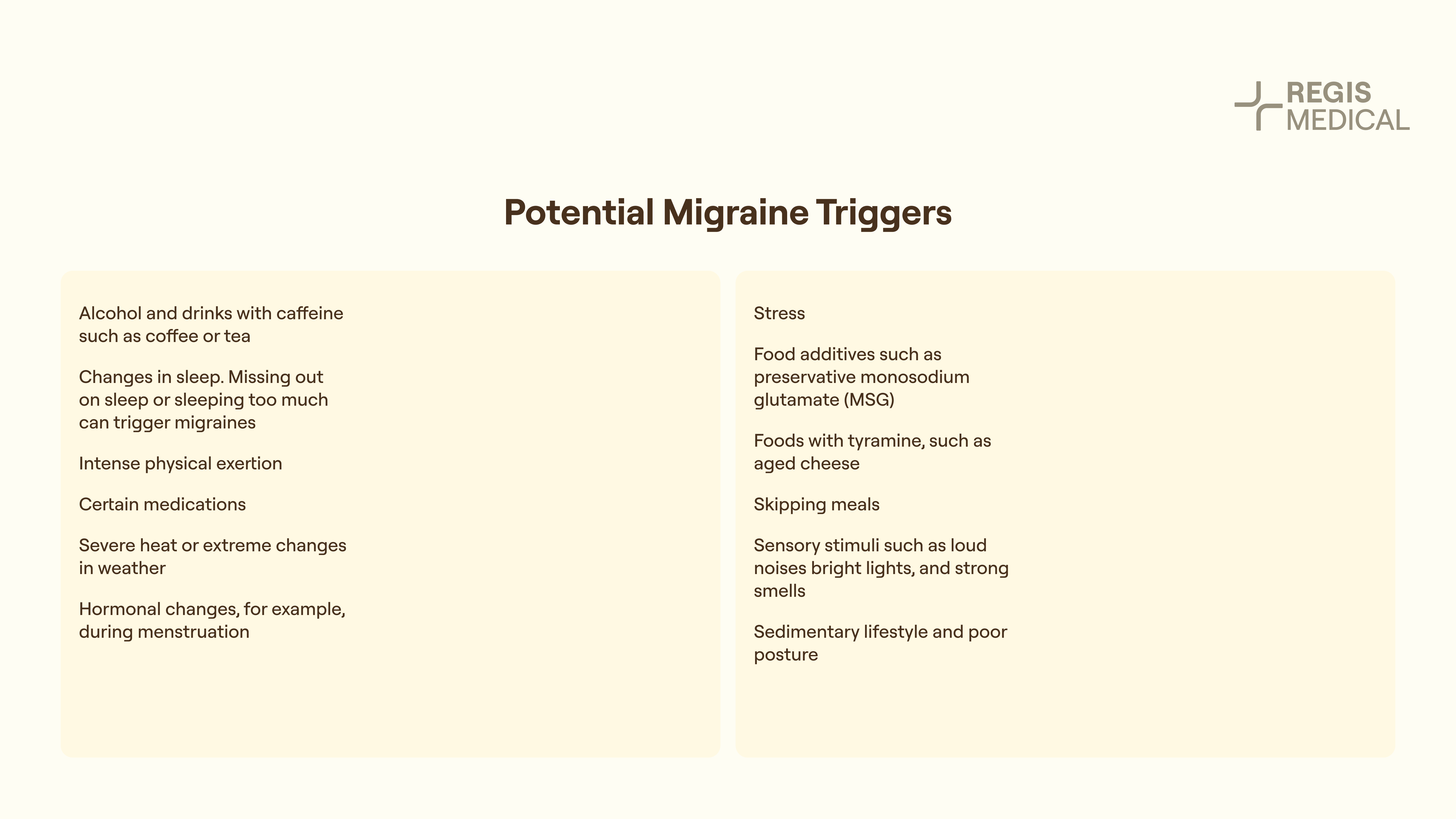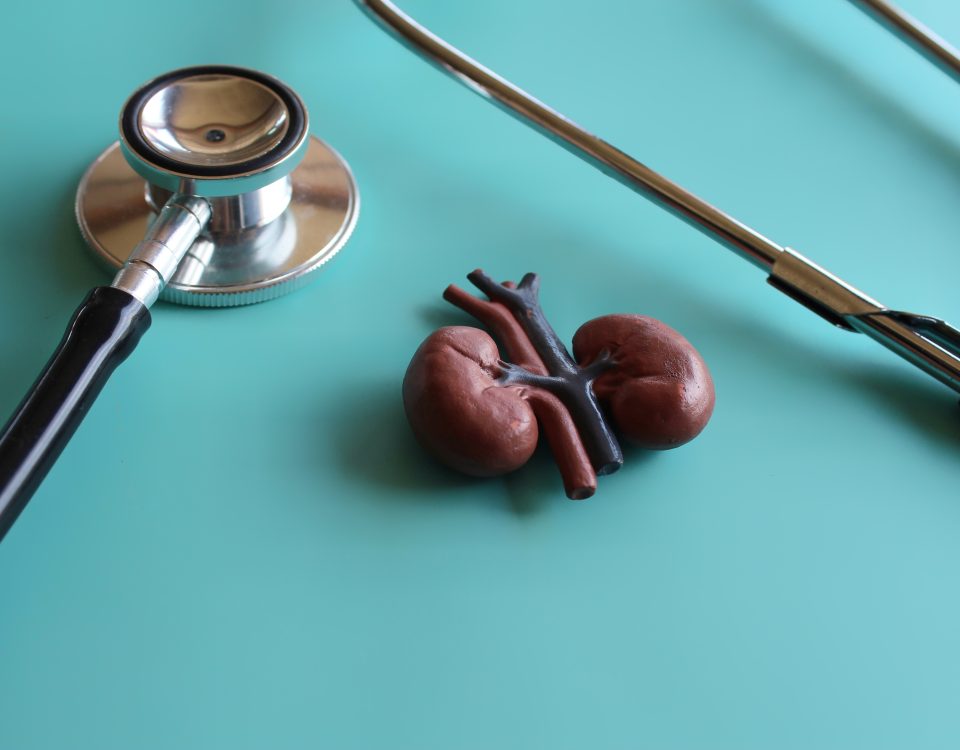Migraine Treatment and Prevention
by: Dr. Paul Chang, General Practitioner, Regis Medical
Last updated: November 28, 2025
Jump to
Migraines in Singapore
According to a study done by Duke-NUS Medical School, migraines affect approximately 1 in 10 Singaporeans and are most common in those aged 30-40. Migraines also tend to be more common in females compared to males, being two to three times more prevalent in women.
Manage Migraine with Regis Medical
Patient-first, Holistic, Dedicated Healthcare
What are Migraines?
Migraine refers to a type of headache that can be chronic for some. The intensity and duration of the headache differ, and it is often accompanied by nausea, vomiting and increased sensitivity to light and sound. The headache can sometimes be so intense that it affects their quality of life and work performance, such as a loss of productivity at work as well as being unable to attend work physically due to migraine.
Most people who experience migraines get them once or twice a month, lasting for a few hours. For a small group of people suffering from migraines, they experience chronic migraines, that happen for at least 15 days a month. The attacks typically last longer for these patients with chronic migraines. The high frequency of migraine attacks makes life difficult for these patients as they struggle to carry out their daily tasks while dealing with headaches.

Types of Migraine
There are many different types of migraines. The most common types of migraines are migraine with aura and migraine without aura. Migraine aura refers to a subjective sensation or disturbance that is caused by changes in the brain.
Migraine with Aura
For migraines with aura, the patient experiences a painful headache along with sensory disturbances that are typically visual. There are various types of auras that can accompany migraines, including:
- Visual aura. This is the most common type of aura experienced, where patients experience temporary visual disturbances, such as seeing spots, flashes, stars, or even experiencing a temporary loss of vision.
- Sensorimotor aura. This refers to sensory or motor disturbances, where patients experience tingling, numbness or weakness in their body.
- Dysphasic aura. Patients experiencing this find themselves unable to talk properly, slurring or mumbling when they attempt to do so.
Migraines with aura can come in four different types that differ according to how the migraine affects the patient’s body.
- Migraine with aura (with or without a headache). This generally refers to the standard migraine with aura experienced.
- Migraine with brainstem aura. For this type of migraine with aura, the aura symptoms come from the base of the brain or both sides of the brain. It is an uncommon form of migraine characterised by vertigo (spinning sensation), instability, and speech disturbance.
- Hemiplegic migraine. In this type of migraine, the aura results in hemiplegia, where the patient experiences weakness on one side of the body, alongside the other symptoms of migraine with aura.
- Retinal migraine. Patients with this type of migraine experience visual aura in one eye, while the other eye retains normal vision.
Migraine without aura
For patients with migraine without aura, they will experience migraine attacks without any aura symptoms.
Menstrual Migraine
Menstrual migraine, or hormone migraines, are migraines that occur before or during a female’s period.
Silent Migraine
In this type of migraine, patients experience other symptoms of a migraine except headache.
Abdominal Migraine
In this type of migraine, patients experience stomach-ache, nausea, and vomiting. This type of migraine tends to be more common in children.
Status Migrainosus
This refers to migraine attacks that last for more than 72 hours. Normal migraines usually last for about 4 to 5 hours.
Vestibular Migraine
In this type of migraine, patients experience symptoms such as dizziness, imbalance or vertigo.
Stages of Migraine
A migraine attack normally progresses through a few stages: prodrome, aura, attack and post-drome. The symptoms in each stage can differ.
1. Prodrome
The prodrome stage occurs a few hours or days before the migraine attack. During this stage, you may experience some warning signs of an upcoming migraine attack. These can include:
- Increased sensitivity to light, sound, or smell
- Fatigue or low energy levels
- Food cravings
- Increased thirst and urination
- Stiffness in the neck
- Frequent yawning
2. Aura
Symptoms experienced during this stage occur due to the nervous system and typically have to do with your vision. This usually happens before a migraine attack, but for some, it can occur together with a headache. Not everyone with migraine will experience this stage, but those who do experience neurological symptoms such as:
- Visual disturbances, such as dark spots, coloured spots, flashes of lights, or hallucinations
- Numbness or tingling sensations
- Weakness
- Difficulty speaking
- Changes in hearing
- Dizziness or vertigo
3. Attack
A migraine attack usually lasts from 4 hours to 72 hours. The severity of the headache and frequency of the attack differs in individuals. Symptoms include:
- Dizziness or feeling faint
- Pain, usually on one side of the head, but can occur on both sides
- Increased sensitivity to light, sound, smell, and touch
- Vomiting
- Nausea
- Throbbing headache
4. Postdrome
This stage occurs after the headache and can last up to a day. Symptoms include:
- Tiredness
- Euphoria, feeling unusually happy
- Muscle pain or weakness
- Feeling hungry or experiencing a loss of appetite
Complications of Migraine
While migraines themselves tend to go away after a period of time and are usually harmless, they can sometimes lead to complications that are far more serious, heavily affecting the patient’s quality of life.
Stroke
Studies have found that patients with migraine are at a significantly higher risk of suffering from ischemic stroke, a type of stroke (/stroke-attack-singapore) that occurs when the body’s blood supply to the brain is interrupted or reduced.
Psychiatric comorbidities
Patients with migraine find themselves at a higher risk of psychiatric comorbidities.
Depression
Depression and migraines have been closely associated. Patients with migraines, especially chronic migraines, have a higher chance of developing depression, or even major depressive disorder.
Anxiety disorders
Studies suggest that more than half of patients suffering from migraine will meet the criteria for at least one anxiety disorder in their lifetime. Generalised anxiety disorder (GAD), obsessive-compulsive disorder (OCD) and panic disorder (PD) are examples of anxiety disorders that have been strongly associated with migraine.
Stress
Patients who experience migraines, especially those with chronic migraines, have been recorded to suffer from higher levels of stress in comparison to people without migraines. Stress can sometimes be a trigger for migraine episodes, further worsening the migraine patient’s condition.
Sleep
Patients with migraine experience a higher amount of sleep disturbances, affecting sleep quality and duration, possibly leading to sleep disorders such as restless leg syndrome, parasomnia, sleep apnoea and insomnia.
Migraine Triggers
While studies have still not been able to discover the cause of migraine, a multitude of possible migraine triggers has been suggested, including hormonal, emotional, physical, dietary, environmental and medicinal factors. Since migraine attacks can heavily affect your quality of life and daily routine, it is advised that you try to find out the migraine triggers that are specific to you and make efforts to avoid them as much as possible. Here is a list of common triggers:
- Alcohol and drinks with caffeine such as coffee or tea.
- Changes in sleep. Missing out on sleep or sleeping too much can trigger migraines.
- Intense physical exertion.
- Medications. Certain types of medication could trigger migraines.
- Severe heat or extreme changes in weather.
- Hormonal changes, for example, during menstruation.
- Stress.
- Food additives such as preservative monosodium glutamate (MSG).
- Foods with tyramine, such as aged cheese.
- Skipping meals.
- Sensory stimuli such as loud noises, bright lights, and strong smells.
- Sedimentary lifestyle and poor posture

Preventing Migraine
A migraine episode can be painful and difficult to deal with. It can interfere and interrupt your daily life, causing you many unwanted problems. Therefore, it is ideal to prevent or reduce the risk of migraine occurrences. Here are some preventive measures for migraines that you can take.
Migraine Medication
Medications such as beta blockers (metoprolol and propranolol), anticonvulsants (topiramate and valproate sodium), antidepressants (amitriptyline), and botulinum toxin type A (botox) have been proven to be effective in preventing migraines when used regularly. However, these medicines bring the risk of causing side effects and should only be used when recommended by a doctor.
Avoiding Migraine Triggers
Understanding what triggers your migraine can be a great help when it comes to preventing migraine episodes. Having a migraine diary can be helpful in determining your migraine triggers so that you can avoid them in the future. For example, if you find yourself experiencing migraines after consuming drinks such as coffee, you could try to avoid it for a period of time and see if this reduces the frequency or intensity of future migraine episodes.
Lifestyle changes
Regular sleep is important when it comes to preventing migraines. Excess sleep or insufficient sleep can be a trigger for migraines, and maintaining a regular sleep schedule can help to reduce the frequency or severity of migraine episodes.
Studies have found stress to be a likely reason for migraine episodes. Stress can sometimes be unavoidable, but some methods can help you manage stress better so that you can avoid migraine episodes. Meditation, yoga or even listening to relaxing music can be options that you can consider to help you wind down after a long day.
Diet
Keeping your mealtimes regular can prevent sudden drops in blood sugar levels, which can be a potential trigger for migraines. It is also important to keep yourself hydrated, as dehydration can also be a migraine trigger.
Exercise
Research has suggested the effectiveness of regular, moderate aerobic exercises in reducing the severity as well as the frequency of migraines, along with lowering overall stress levels. It is important to keep your exercises at a moderate level and not overstrain your body since straining the body could also be a potential migraine trigger.
Fixing poor body posture
Many Singaporeans spend the majority of their time seated down, be it at work or home. Poor body posture, coupled with a sedimentary lifestyle can cause the muscles in the neck, shoulders and upper back area to be tensed up and strained, leading to headaches. By fixing your body posture, you can relieve the stress in these muscles and lower the risk of headaches occurring.
Migraine Treatment and Cure
Medication can be prescribed to treat acute migraine as well as relieve pain in the cases of chronic migraine attacks. These include:
- Non-Steroidal Anti-Inflammatory Drugs (NSAIDs), such as ibuprofen and naproxen sodium, are effective in relieving pain caused by migraine.
- Triptans, such as sumatriptan and rizatriptan, are regularly used to treat moderate to severe cases of migraine, capable of relieving headaches.
- Dihydroergotamine, in the form of nasal sprays or injections, is absorbed directly into the bloodstream and is a fast-acting pain relief.
- Opioid medication, such as butorphanol and codeine, can be used to treat migraine for patients who are unable to accept or do not respond positively to the usual forms of treatment.
- Anti-nausea drugs. For those experiencing migraines with aura causing nausea and vomiting, they can consider anti-nausea drugs, such as chlorpromazine or metoclopramide, as a treatment for their migraine symptoms.
However, do note that there can be side effects for the medication listed above, especially when used over a long period. The medication may not be suitable for everyone’s use, such as in the case of pregnant women. You should consult a trusted healthcare provider if you are worried if the medication prescribed is suitable for you.
Manage Migraine with Regis Medical
Patient-first, Holistic, Dedicated Healthcare
Disclaimer:
The information on this website, including but not limited to, text, graphics, images, videos and all other materials contained on this website is for informational purposes only. None of the material is meant to replace a certified and registered Doctor's professional medical advice, diagnosis, and treatment.
No warranties or representations are given in respect of the medical information. Regis Medical, Regis Medical’s staff, and the website's operator will not be held liable if a user suffers any injury or loss after relying upon the medical information on this website.
Any devices used for technology-enhanced therapies are intended for use only for general well-being purposes or to encourage or maintain a healthy lifestyle and is not intended to be used for any medical purpose (such as the detection. diagnosis, monitoring, management or treatment of any medical condition or disease). Any health-related information provided by this device or software should not be treated as medical advice. Please consult a certified and registered Doctor for any medical advice required.
Benli, Ali Ramazan, and Didem Sunay. “Changing Efficacy of Wet Cupping Therapy in Migraine with Lunar Phase: A Self-Controlled Interventional Study.” Medical science monitor : international medical journal of experimental and clinical research vol. 23 6162-6167. 29 Dec. 2017, doi:10.12659/msm.905199
“Duke-NUS Medical School - All News.” DukeNUS, DukeNUS Medical School, 18 Sept. 2019, https://www.duke-nus.edu.sg/allnews/migraine-is-a-billion-dollar-headache-for-singapore-nationwide-study-finds#:~:text=In%20Singapore%2C%20migraine%20affects%20up,National%20University%20Hospital%20(NUH.
Erickson, Nancy. “What Are the Stages of a Migraine?” Mayo Clinic Health System, Mayo Clinic Health System, 24 Mar. 2021, https://www.mayoclinichealthsystem.org/hometown-health/speaking-of-health/what-are-the-stages-of-a-migraine.
“Everything You Want to Know About Migraine.” Migraine: Symptoms, Causes, Treatment, Triggers, and More, Healthline Media, 27 Oct. 2021, https://www.healthline.com/health/migraine#symptoms.
“Headache and Migraine.” HealthHub, HealthHub, 28 Jan. 2021, https://www.healthhub.sg/a-z/diseases-and-conditions/649/headache-and-migraine.
“Hemiplegic Migraine: Symptoms and Treatments.” Hemiplegic Migraine: Symptoms & Treatments: AMF, American Migraine Foundation, 6 Jan. 2022, https://americanmigrainefoundation.org/resource-library/hemiplegic-migraine/.
Hu, Liangen et al. “Different Chinese patent medicine therapies for migraine: A protocol for systematic review and network meta-analysis.” Medicine vol. 100,2 (2021): e24179. doi:10.1097/MD.0000000000024179
Jahangir, Saira et al. “Is There an Association Between Migraine and Major Depressive Disorder? A Narrative Review.” Cureus vol. 12,6 e8551. 10 Jun. 2020, doi:10.7759/cureus.8551
Laura Mayans, Anne Walling, “Acute Migraine Headache: Treatment Strategies” American Family Physician 2018;97(4):243-251.
“Migraine - Diagnosis and Treatment.” Mayo Clinic, Mayo Foundation for Medical Education and Research, 2 July 2021, https://www.mayoclinic.org/diseases-conditions/migraine-headache/diagnosis-treatment/drc-20360207.
“Migraine with Brainstem Aura (Basilar Type Migraine).” Understanding Migraine with Brainstem Aura: AMF, American Migraine Foundation, 8 Aug. 2016, https://americanmigrainefoundation.org/resource-library/migraine-with-brainstem-aura/.
“Migraine.” Mayo Clinic, Mayo Foundation for Medical Education and Research, 2 July 2021, https://www.mayoclinic.org/diseases-conditions/migraine-headache/symptoms-causes/syc-20360201#:~:text=A%20migraine%20is%20a%20headache,sensitivity%20to%20light%20and%20sound.
“Migraine prevention in adults” InformedHealth.org. Cologne, Germany, Institute for Quality and Efficiency in Health Care (IQWiG); 2006. Available from: https://www.ncbi.nlm.nih.gov/books/NBK328460/
Minen MT, Begasse De Dhaem O, Kroon Van Diest A, et al. “Migraine and its psychiatric comorbidities.” Journal of Neurology, Neurosurgery & Psychiatry 2016;87:741-749.
Øie LR, Kurth T, Gulati S, et al. “Migraine and risk of stroke.” Journal of Neurology, Neurosurgery & Psychiatry 2020;91:593-604.
Payant, Misha-Josef. “A single case study: treating migraine headache with acupuncture, chinese herbs, and diet.” Global advances in health and medicine vol. 3,1 (2014): 71-4. doi:10.7453/gahmj.2013.060
Ratini, Melinda. “What Is Migraine?” Migraine: Symptoms, Causes, Diagnosis, Treatment, and Prevention, WebMD, 18 July 2020, https://www.webmd.com/migraines-headaches/migraines-headaches-migraines.
“Retinal Migraine: Symptoms, Causes and Treatment.” Retinal Migraine: Symptoms, Causes and Treatment: AMF, American Migraine Foundation, 12 May 2022, https://americanmigrainefoundation.org/resource-library/retinal-migraine/.
Schwickert, Myriam E et al. “Gua Sha bei Migräne in der stationären Entzugsbehandlung von medikamenteninduziertem Kopfschmerz” [Gua Sha for migraine in inpatient withdrawal therapy of headache due to medication overuse]. Forschende Komplementarmedizin (2006) vol. 14,5 (2007): 297-300. doi:10.1159/000107731
“Stages of a Migraine Attack.” The Migraine Trust, The Migraine Trust, 18 Nov. 2021, https://migrainetrust.org/understand-migraine/stages-of-a-migraine-attack/#page-section-4.
“Understanding Migraine with Aura.” Migraine with Aura: Types, Symptoms & Treatments: AMF, American Migraine Foundation, 6 July 2017, https://americanmigrainefoundation.org/resource-library/understanding-migraine-aura/.
Urits, I., Patel, M., Putz, M.E. et al. “Acupuncture and Its Role in the Treatment of Migraine Headaches.” Neurol Ther 9, 375–394 (2020). https://doi.org/10.1007/s40120-020-00216-1


